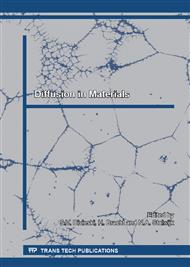p.173
p.178
p.186
p.190
p.196
p.202
p.210
p.219
p.225
Effects of Compression Tests on Point Defects in Pure Ni and Ni-16wt%Cr Model Alloys
Abstract:
On Ni and Ni-16wt%.Cr model-alloys compressed at 30 % and 60 % deformation, point-defects and dislocations concentrations are respectively characterized by positron annihilation spectroscopy and x-ray diffraction analysis. The positron results show that only mono-vacancies are formed during compressive test The X-ray results allows us to quantify the dislocation concentration in the systems. Saturation of defect densities is observed in measurements for these high deformation rates. In support to the experimental work, an homogeneous kinetic model is used to characterize point-defect – dislocation interactions to estimate the kinetics of vacancy restoration to equilibrium concentration.
Info:
Periodical:
Pages:
202-209
Citation:
Online since:
May 2015
Price:
Сopyright:
© 2015 Trans Tech Publications Ltd. All Rights Reserved
Share:
Citation:


